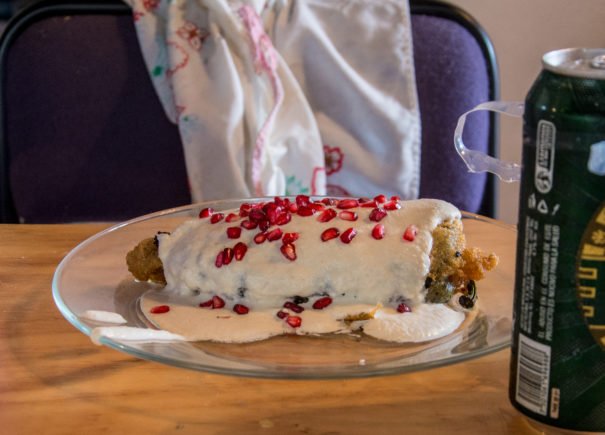
You Can Never Have Too Many Cooks Stuffing Chilis

You Can Never Have Too Many Cooks Stuffing Chilis
Chiles en Nogada in Puebla
It was chile en nogada season in Puebla. Everyone was talking about how many they had eaten, and where: everyone had a favorite restaurant, although the consensus was that the homemade ones are always the best.
So my friends and I decided to do just that—make them ourselves, although nobody really had a clue how to go about it.
Chiles en nogada are a Mexican gastronomic icon. A whole poblano chili, filled with picadillo—a mixture of meat, fruit, and spices. It’s a most patriotic dish, representing the three colors of the Mexican flag: white from the creamy walnut (nogada) sauce, red from the pomegranates sprinkled over it, and green from the parsley garnish.
There are many legends about the dish’s creation, and rules about which recipe to follow, and the best time and place to prepare it. They say the original and best version is served in the state of Puebla between July 15 and September 30, with locally grown apples, pears, peaches, plantains, nuts, and pomegranate.
According to the most popular legend, nuns from Santa Monica convent invented the tri-color dish to celebrate Agustin de Iturbide—the Mexican army general and later emperor who was instrumental in fighting for independence from Spain—on his way through the city of Puebla, and to commemorate the country’s recent triumph over its colonial rulers. Another claims it was first served by some the emperor’s soldiers’ girlfriends to celebrate the troops’ arrival.
Legends aside, one thing about this revered dish certainly holds true: preparing it is a laborious process.
We had to do all the shopping the day before, or we would have sat down to eat at midnight. So we gathered in the market and bought around 22 pounds of ingredients, splitting the bags strategically so that each team could chop some of the fruit in advance.
My partner and I were assigned one of the most challenging parts of the process: roasting and cleaning the chilis. My partner’s eyes were soon sore and he sneezed constantly as the smoke from the burning chilis filled the kitchen. When they were totally black, we put them into a plastic bag for 15 minutes before skinning them and opening them to dig out the seeds and veins.
When we arrived at Rafa’s home the next day, the garden was already a hive of activity. Agnija was busy chopping the last of the peaches; Adriana was struggling to whisk egg whites into snowy peaks; Cassandra was puréeing nuts, cream, and cheese; Dario was cleaning pomegranates. Nereo was mixing the music. Mirna, the only one who had witnessed the creation of chiles en nogada before, was frying onions, pork, and beef. She was also in charge of mixing meat and fruits in a huge pot, filling the chilis, rolling them in beaten egg, frying them, and taking them out of the boiling oil.
Four hours later, we served the chiles en nogada with a nutty cream, heavily spiced with bourbon, sprinkled with pomegranate seeds, and decorated with chopped parsley leaves. Despite one minor mishap—when the pot slid off the fire and turned over, spitting out some of the filling—the endeavor was a success. It was the first and the last time I ate two chiles en nogada in one sitting.